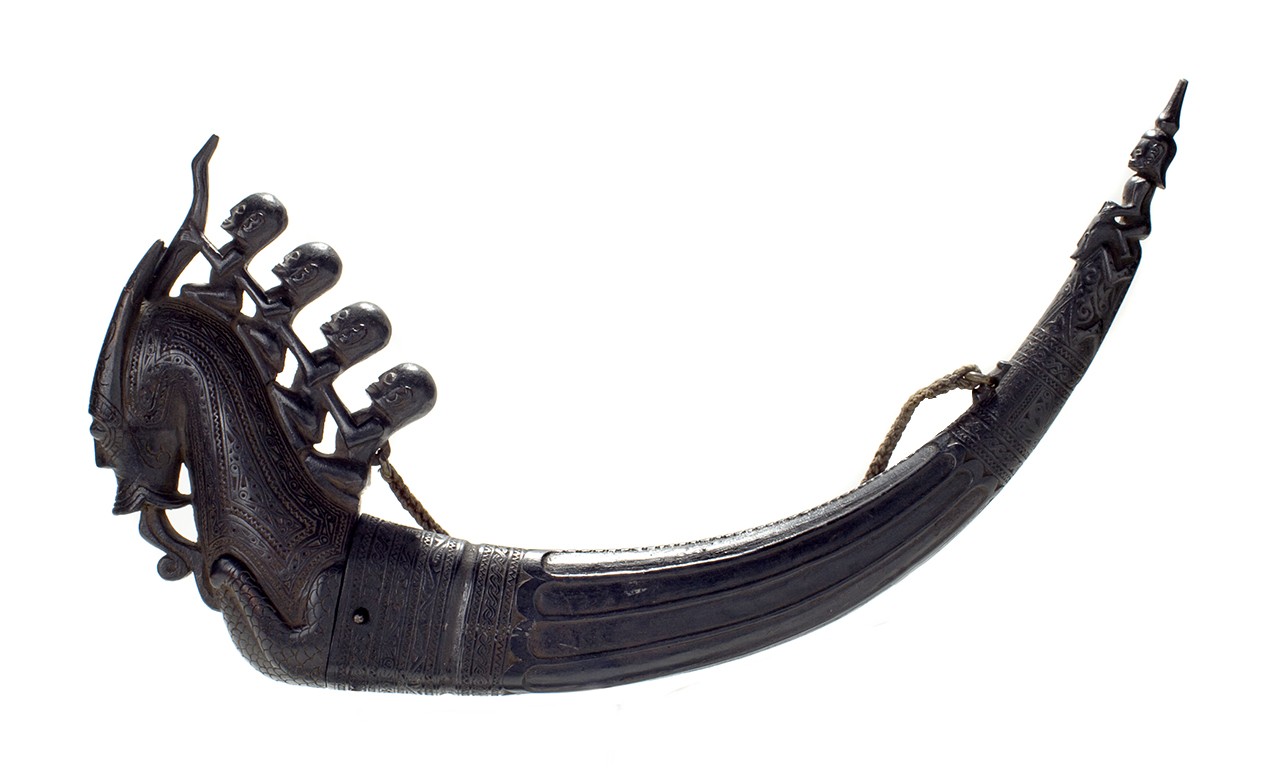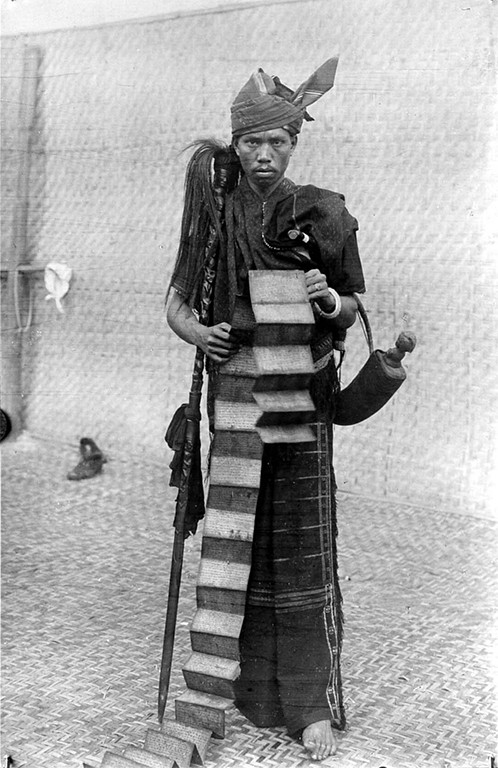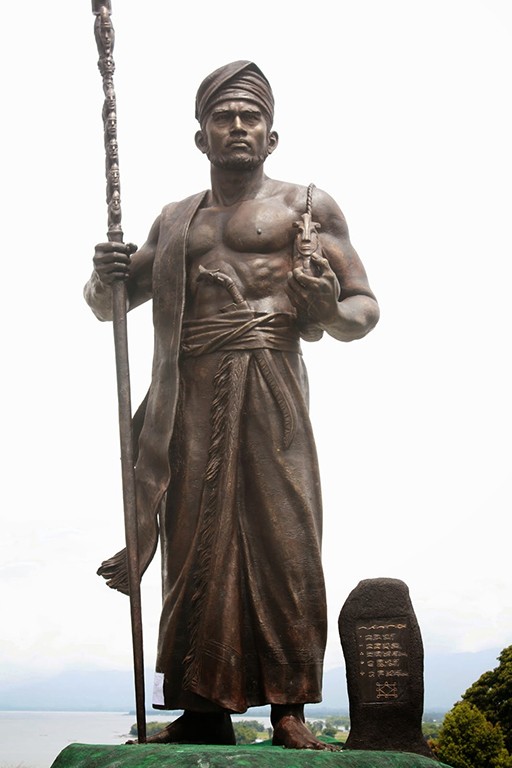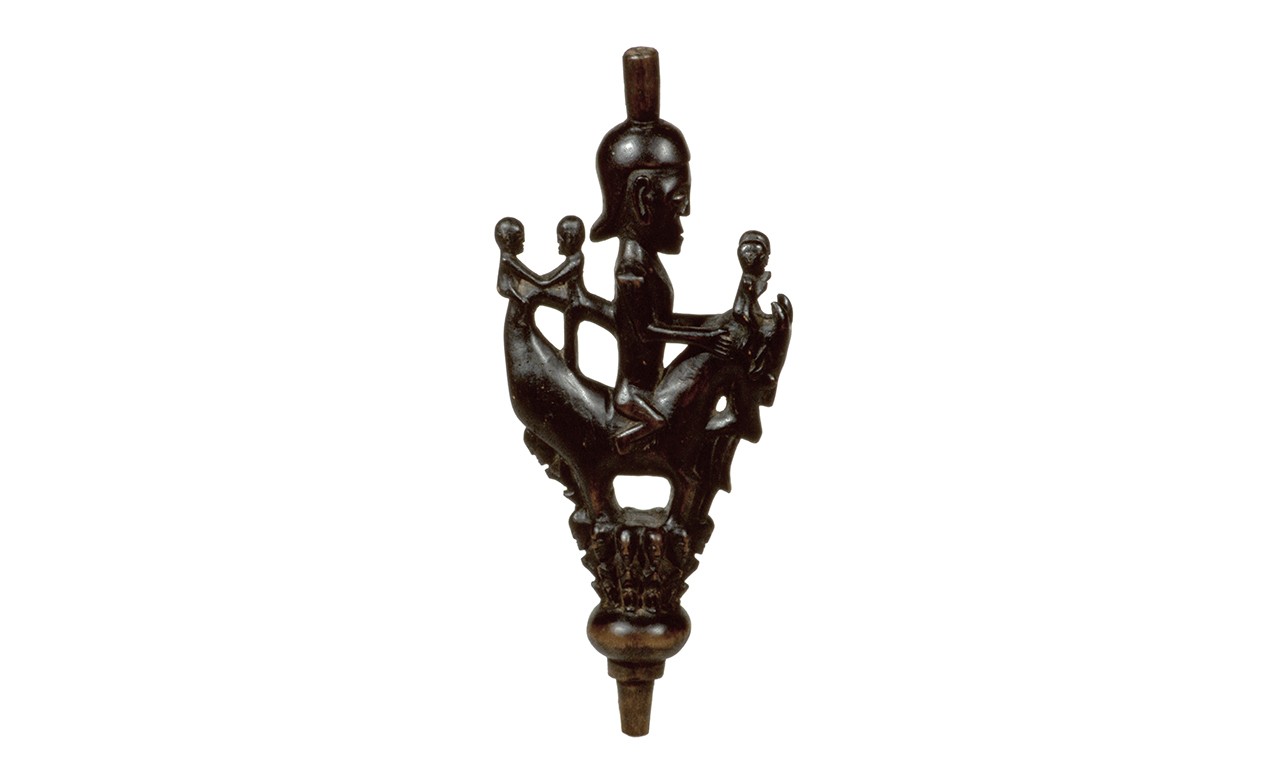 |
Medicine or Magic Horn (Naga Marsarang), early 20th century
Unrecorded Batak Toba artist; Sumatra, Indonesia
Buffalo horn, wood, brass, and plant fiber; 12 1/2 × 2 1/4 × 21 in.
2004.67.1
Bowers Museum Purchase with Funds Provided by Don and Barbara Greek |
Indonesian Carvings
Among the Bowers’ collection of objects from the Indonesian archipelago, some of the most intricately carved are horns which were used, as they have been in cultures across the world, as containers of powerful substances: medicines, narcotics, magics, gunpowder, and more. This post brings together two distinct objects made by the Batak culture of northern Sumatra and explores how the two are unique in both function and key elements of their design despite sharing a general shape.
 |
 |
Portrait of a Batak Toba datu, 1929 (TM-10000813)
Collection of the Wereld Museum |
Bronze statue of Si Raja Batak at the Museum Batak TB Silalahi Center Muhibbun Ritonga |
On The Toba Batak
Batak is a language group encompassing six related cultures that live in the northern environs of Sumatra: the Karo, Pakpak, Simalungun, Toba, Angkola, Mandailing. While each group retains a strong individual identity, they all share in many traditions, not the least of which is a legendary primogenitor, Si Raja Batak. All Batak people also historically recognized the importance of datu, high-ranking members of society who could communicate with the dead, conduct ceremonies, practice benevolent and malevolent magic, and aid in matters concerning daily life. Secondary to ornately carved wooden staffs, the magic horn featured in this post, or naga marsarang, was among the more important objects used by datu. Many early photographs of datu show them with such horns slung under their shoulders and a large bronze statue of Si Raja Batak at the Museum Batak TB Silalahi Center overlooking Lake Toba depicts the iconic figure with a naga marsarang.

 |
Detail of 2004.67.1
Bowers Museum Purchase with Funds Provided by Don and Barbara Greek |
Holding Pupuk
Naga marsarang were created to hold a substance called pupuk which was used by datu in their magic. Pupuk was prepared, used, and handled only by datu, who had to adhere to strict guidelines. Only a few types of containers could be used to hold pupuk, as to not store the substance in an appropriate container was to risk disaster. Chinese trade ceramics as well as wood and leaden vessels could be employed for this purpose, but the horns allowed the powder to be transported easily.
 |
Bottle Stopper, late 19th to early 20th century
Unrecorded artist, Batak culture; Sumatra, Indonesia
Wood; 13 x 2 1/4 x 6 in.
F80.71.3
Gift of Mr. and Mrs. James Zukin |
On the Horn
The carved container is a composite of buffalo horn and carved wood; these pieces are held together with two wood pegs on opposite sides. Overall, the medicine horn is incised with repeating bands of zigzagging lines and swirling patterns. The main body of the horn is carved in relief with elegant long lines terminating in round scalloped edges. The tip of the horn depicts a human form sitting atop a zoomorphic creature that has a curled tail and repeating triangular patterned skin; the horns of the creature are grasped tightly by the figure. The wooden elements of the medicine horn represent a singa, a mythological animal considered to have protective qualities. It is commonly incorporated into Batak Toba house design and the adornment of important objects. Four human figures ride on the back of the singa’s neck, holding each other around the waist. That the bottle stopper featured in this post has a remarkably similar design with four individuals riding a singa is no coincidence. It would have been used to seal another type of container for pupuk, such as one of the aforementioned trade ceramics.

 |
Powder Horn (Parpanggalahan), late 19th century
Unrecorded artist, Batak culture; Sumatra, Indonesia
Wood, string and glass beads; 13 1/2 × 7 1/2 × 2 in.
2018.10.5
Gift of the Goldenberg Estate and the Sweeney Family |
Volatile Cargo
This horn was made for holding a very different substance, and as such varies from the first in size, medium, and design. As firearms began spreading and then rebounding throughout the world in the 13th century, cultures began to develop first utilitarian and later highly ornamental versions of related equipment. We know this horn was used to store gunpowder because experts have recorded its distinctive lingering odor, making it a parpanggalahan. Prior to colonial control, most Batak homes kept a store of gunpowder for use with their muzzle-loaded weapons. Village chiefs could afford to carry small supplies of gunpowder with them in these horns, which were traditionally carved from water buffalo horn like the naga marsarang. This object is carved from wood but takes the shape of a horn. Its strap appears to be made of small shell beads rather than from similarly sized European trade beads.
Text and images may be under copyright. Please contact Collection Department for permission to use. References are available on request. Information subject to change upon further research.








Comments